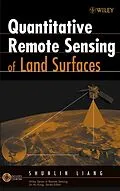Processing the vast amounts of data on the Earth's land surface
environment generated by NASA's and other international satellite
programs is a significant challenge. Filling a gap between the
theoretical, physically-based modelling and specific applications,
this in-depth study presents practical quantitative algorithms for
estimating various land surface variables from remotely sensed
observations.
A concise review of the basic principles of optical remote sensing
as well as practical algorithms for estimating land surface
variables quantitatively from remotely sensed observations.
Emphasizes both the basic principles of optical remote sensing and
practical algorithms for estimating land surface variables
quantitatively from remotely sensed observations
Presents the current physical understanding of remote sensing as a
system with a focus on radiative transfer modelling of the
atmosphere, canopy, soil and snow
Gathers the state of the art quantitative algorithms for sensor
calibration, atmospheric and topographic correction, estimation of
a variety of biophysical and geoph ysical variables, and
four-dimensional data assimilation
Autorentext
SHUNLIN LIANG, PhD, is an associate professor in the Department of Geography at the University of Maryland, where he teaches courses in remote sensing, quantitative spatial analysis, and computer cartography. He is the Associate Editor for IEEE Transactions on Geoscience and Remote Sensing and the coeditor of Geographic Information Science.
Klappentext
A comprehensive resource of basic principles and practical algorithms
Remote sensing of land surfaces has entered a new era. A series of operating satellites from the NASA Earth Observing System (EOS) program, other international programs, and commercial programs are producing tremendous volumes of data at significantly higher levels of measurement precision. In order to effectively interpret the data and estimate Earth surface variables, scientists require ever more sophisticated and targeted quantitative algorithms. Quantitative Remote Sensing of Land Surfaces fills this reference need, connecting theoretical, physically based modeling to specific applications.
Shunlin Liang divides his much-needed resource into two parts. The first presents the current understanding of optical remote sensing with an emphasis on radiative transfer modeling of the atmosphere, canopy, soil, and snow. The second, greater part of the text, discusses a variety of practical algorithms for estimating land surface variables quantitatively. It includes state-of-the-art quantitative algorithms for:
- Sensor calibration
- Atmospheric and topographic correction
- Estimation of a variety of biophysical and geophysical variables
- Four-dimensional data assimilation
The book cites more than 1,300 references, and the companion CD-ROM includes useful computer program codes and valuable data sets. The author assumes no special mathematical background beyond a good working knowledge of statistics, calculus, and linear algebra on an undergraduate level.
Graduate students as well as practitioners of interdisciplinary research on the Earth’s land surface environment will find Quantitative Remote Sensing of Land Surfaces to be a peerless addition to the professional literature.
Zusammenfassung
Processing the vast amounts of data on the Earth's land surface environment generated by NASA's and other international satellite programs is a significant challenge. Filling a gap between the theoretical, physically-based modelling and specific applications, this in-depth study presents practical quantitative algorithms for estimating various land surface variables from remotely sensed observations.
A concise review of the basic principles of optical remote sensing as well as practical algorithms for estimating land surface variables quantitatively from remotely sensed observations.
Emphasizes both the basic principles of optical remote sensing and practical algorithms for estimating land surface variables quantitatively from remotely sensed observations
Presents the current physical understanding of remote sensing as a system with a focus on radiative transfer modelling of the atmosphere, canopy, soil and snow
Gathers the state of the art quantitative algorithms for sensor calibration, atmospheric and topographic correction, estimation of a variety of biophysical and geoph ysical variables, and four-dimensional data assimilation
Inhalt
Preface xv
Acronyms xix
Chapter 1 Introduction 1
Chapter 2 Atmospheric Shortwave Radiative Transfer Modeling 25
Chapter 3 Canopy Reflectance Modeling 76
Chapter 4 Soil and Snow Reflectance Modeling 143
Chapter 5 Satellite Sensor Radiometric Calibration 178
Chapter 6 Atmospheric Correction of Optical Imagery 196
Chapter 7 Topographic Correction Methods 231
Chapter 8 Estimation of Land Surface Biophysical variables 246
Chapter 9 Estimation of Surface Radiation Budget: I. Broadband Albedo 310
Chapter 10 Estimation of Surface Radiation Budget: II. Longwave 345
Chapter 11 Four-Dimensional Data Assimilation 398
Chapter 12 Validation and Spatial Scaling 431
Chapter 13 Applications 472
Appendix CD-ROM Content 525
Index 528
